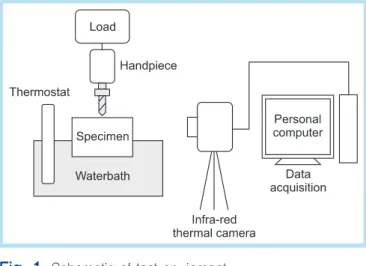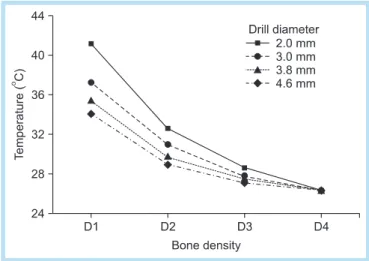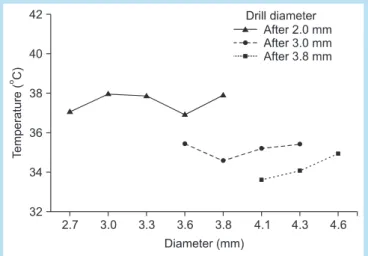Abstract
Purpose: The purpose of this study was to examine the difference in temperature change according to bone density, drilling speed, irrigation, length and width of the drill during implant-site preparation.
Materials and Methods: During drilling, temperature measurement was performed by means of an infrared thermal camera in order to detect temperature changes. According to Misch’s classification D1 to D4 laminated test blocks made of polyurethane foams were used for the experiment with a maintenance of temperature at 36.5
oC (waterbath). Temperature change was measured while drilling with four bone blocks of different densities. Also, the speed of revolution, drill length and irrigation were factors evaluated for heat generation during drilling with implant. Analysis on the effect of the drill diameter and the effect of size of the previous drill diameter on heat generation was performed.
Results: From D1 to D4 bone, heat generation was the greatest with D1. When the speed of drills was kept constant at 1,200 rpm, greater heat was generated. When the drill length increased, more heat was generated. Hence, there seems to be a remarkable temperature difference when there is an increase in drill length and drill time. Also, there is a significant temperature difference during implant site preparation between bone with and without irrigation. However, no significant difference in temperature changes was found with the drilling procedure; yet, the effect of a previous drill diameter on heat generation was confirmed during the use of the final drill. The smaller the previous drill diameter is, the more the temperature increases when preparing an implant site with the final drill.
Conclusion: Within the limitations of this pilot study, the observations suggest that accelerated speed of revolution, longer drill length and smaller previous drill diameter generate more heat when preparing the implant site. Moreover, irrigation is an important factor for reducing heat generation during osteotomy preparation. Further studies should be conducted in order to determine the ideal surgical protocols in vivo.
Key Words: bone density, drill, heat generation, implant, irrigation
임플란트 드릴링 시 발생하는 열과 그 원인에 대한 분석
한선희
1
, 김병국2
, 김범익2
1서울대학교 치의학대학원 치주과학교실, 2오스템임플란트연구소
Temperature Measurement during Implant-site Preparation
Seon-Hee Han1, Byoung Kook Kim2, Beom Ik Kim2
1
Department of Periodontology, School of Dentistry, Seoul National University, Seoul, Korea
2
Osstem R&D Center, Busan, Korea
ISSN 1229-5418 Implantology 2013; 17(4): 268~274
Reprint requests: Seon-Hee Han
Department of Periodontology, School of Dentistry, Seoul National University, 101, Daehak-ro, Jongno-gu, Seoul 110-749, Korea
Tel: 82-2-2072-2648, Fax: 82-2-744-0051 E-mail: tasdream@naver.com
Received for publication: December 12, 2013 Accepted for publication: December 15, 2013
교신저자: 한선희
(110-749) 서울시 종로구 대학로 101 서울대학교 치의학대학원 치주과학교실 Tel: 82-2-2072-2648, Fax: 82-2-744-0051 E-mail: tasdream@naver.com
원고접수일: 2013년 12월 12일 게재확정일: 2013년 12월 15일
Copyright © 2013. The Korean Academy of Oral & Maxillofacial Implantology
열 발생 부분에 초점을 두어, 열에 의한 골의 괴사를 최 소화할 수 있는 수술 과정에 대한 연구의 초석을 다지는 데 의미를 두었다. 골의 밀도, rpm, 드릴의 길이, 주수 (irrigation) 유무, 그리고 드릴의 직경을 다섯 가지 요인 으로 두고 이들을 변화시키면서 임플란트 식립 시 온도 변화가 어떻게 일어나는지에 대해 조사하였다.
II
연구재료 및 방법이번 연구는 2010년 10월부터 11월까지 오스템임플란트 연구소에서 이루어졌다. 수조의 온도는 36oC~37oC로 유 지되었으며 주변 온도는 25oC인 환경에서 실험이 진행되 었다. 시편 위에 핸드피스(handpiece)와 지그(jig, 0.9 kg), 측정기구(scale, 1.1 kg)가 위치하였고 시편은 Misch’s classification5에 따라 D1~D4 laminated test block-poly- urethane foam (Sawbones Inc., Vashon, WA, USA)이 사용
치과용 임플란트는 Brånemark 등1의 골유착 (osseointegration) 발견 이후 끊임없는 발전 을 거듭해 왔다. Brånemark 등1이 밝혀낸 골 유착은 임플란트의 표면과 living bone 사이에 연조직 층 의 생성이 없이 직접 골조직이 형성되어 접착이 되는 것 을 뜻한다. 하지만 모든 임플란트의 골유착이 성공적으 로 일어나는 것은 아니다. 성공적인 골유착이 될 수도 있 지만, 임플란트 식립 후에 급성 또는 만성 염증이 발생하 여 조기에 실패하거나, 임플란트와 골 사이에 연조직이 생성되어 골유착 실패(osseointegration failure)가 일어 날 수도 있다2,3.
임플란트 실패의 원인 중 하나가 과도한 외과적 상해 (surgical trauma)이며, 외과적 상해는 임플란트 표면과 골 조직 사이에 섬유조직(fibrous tissue)을 생성되게 한다.
임플란트 식립 수술 중에 골괴사를 일으킬 수 있는 요인 들로는 열 발생, 압축(compression), 진동(vibration) 등 이 있다. 특히 47oC를 넘는 열의 발생은 골흡수와 지방세 포 변성을 일으키고, 열에 의해 손상된 골조직은 덜 분화
Table 1.
Density and thickness of cortical layer and sponge layer of 4 test specimensGrade
Cortical layer Sponge layer Density
(g/cc)
Thickness (mm)
Density (g/cc)
Thickness (mm) D1
D2 D3 D4
0.80 0.80 0.80 -
3 2 2 -
0.48 0.32 0.16 0.16
27 28 28 30 D1~D4: Misch’s bone density classification5.
Seon-Hee Han et al. : Temperature Measurement during Implant-site Preparation.
Implantology 2013
Fig. 1.
Schematic of test equipment.Seon-Hee Han et al. : Temperature Measurement during Implant-site Preparation.
Implantology 2013
Original Article
되었다(Table 1). 드릴은 Twist drill (Osstem Implant Co.
Ltd., Seoul, Korea)을 사용하였다. 실험장비의 모식도는 Fig. 1과 같다.
온도의 측정은 infra-red thermal camera (IRI1001;
Irisys Ltd., Northampton, UK)가 사용되었다(Fig. 2).
Waterbath 내에서 실험이 이루어지면 infra-red ther- mal camera로 촬영을 하고 그 자료는 컴퓨터로 전송되 어 온도의 변화에 대해 실시간으로 알아볼 수 있었다.
테스트는 6단계로 이루어졌다. 첫 번째로 골의 밀도와 온도의 상관관계를 알아보았다. D1~D4의 시편을 사용 하여 irrigation하에 드릴링(drilling)하였다. 두 번째로는 rpm과 온도의 상관관계를 알아보았고, 500~1,500 rpm 으로 실험하였다. 세 번째로는 드릴의 길이와 온도의 연 관성을 알아보았고 irrigation하에 7~15 mm의 다양한 길이의 드릴을 사용하여 실험하였다. 네 번째로는 irri- gation 유무에 따른 열 발생에 대해 알아보았다. 다섯 번 째 실험은 직경 2.0 mm, 3.0 mm, 3.8 mm의 드릴로 드 릴링한 후에 다음 단계의 드릴 직경에 따른 온도변화를 관찰하였다. 여섯 번째 실험은 직경 4.3 mm의 드릴로 드
릴링하기에 앞서 전 단계에서 직경 2.7~4.1 mm의 다양 한 드릴을 사용하여 드릴링함으로써 이전 단계 드릴 직 경에 따른 온도 변화를 조사하였다.
III
연구결과1. Temperature vs. bone density
Misch’s classification5에 따라 D1~D4 골질의 시편에 서 4가지 직경의 드릴을 사용하여 시험하였다. D1, 즉 가 장 단단한 골 시편에서 온도 증가가 가장 컸으며 D2, D3, D4 순으로 점차 감소하였다(Fig. 3). 각 시편에서는 드릴 의 직경이 작을수록 온도가 더 많이 증가하였고, 직경에 따른 온도 변화의 차이는 D1에서 가장 컸고, D4는 직경 과 관계없이 거의 일정한 온도를 보였다.
2. Temperature vs. rpm
드릴의 회전속도가 커질수록 온도가 점차 증가하다가
Fig. 2.
Display of thermal distribution.Fig. 3.
Temperatures according to bone density. D1~D4:Misch’s bone density classification5.
3. Temperature vs. drill length
드릴의 길이가 7 mm에서 15 mm인 범위 내에서 6가지로 실험하였다. 7 mm에서 8.5 mm까지는 유의미한 온도의 증
4. Temperatures vs. irrigation & non irrigation
Irrigation을 한 경우 온도 변화의 폭이 작고, 단시간 내
Fig. 5.
Temperatures according to drill lengths.Seon-Hee Han et al. : Temperature Measurement during Implant-site Preparation.
Implantology 2013
Fig. 4.
Temperatures according to speed of revolutions.Seon-Hee Han et al. : Temperature Measurement during Implant-site Preparation.
Implantology 2013
Fig. 6.
Real time comparative result of temperatures both with and without irrigations (diameter 2.7 mm drill after using 2.0 mm drill).Seon-Hee Han et al. : Temperature Measurement during Implant-site Preparation.
Implantology 2013
Fig. 7.
Temperature during diameter 4.3 mm drilling according to previous drill diameters.Seon-Hee Han et al. : Temperature Measurement during Implant-site Preparation.
Implantology 2013
Original Article
에 냉각(cooling)되는 것을 관찰하였다. 이번 실험에서도 irrigation이 없이 드릴링한 경우 최고 48oC까지 증가하 고 온도가 다시 내려가는 데 걸리는 시간도 길었다(Fig.
6).
5. Evaluation of the effect of next drill diameter on heat generation
이전 단계 드릴의 직경이 작을수록(3.8 mm, 3.0 mm, 2.0 mm) 온도가 높게 나타났다. 직경 2.0 mm 드릴을 사 용한 후에 5가지 크기의 드릴을 사용하여 실험하였는데 온도의 차이는 크지 않았으나 온도가 37oC에서 38oC 정 도로 나타났다. 직경 3.0 mm의 드릴을 사용한 후에는 약 34oC에서 35oC 정도 온도를 보였다. 직경 3.8 mm의 드릴 을 사용한 후에는 더 낮은 온도가 측정되었으나 이것의 차이는 드릴의 직경 차이에 의한 열 발생의 차이로 생각 된다. 직경 3.8 mm의 드릴을 사용한 후에 다음 단계 드 릴의 직경이 커질수록(4.1 mm, 4.3 mm, 4.6 mm) 온도 의 증가가 크게 나타났다(Fig. 7).
6. Evaluation of the effect of previous drill diameter on heat generation
직경 4.3 mm의 드릴을 사용하기 전에 다양한 직경의 드릴링을 해보았다. 다음 단계 드릴과 직경 차이가 작을 수록 열 발생이 적었다(Fig. 8).
IV
총괄 및 고찰Misch’s classification5에 의해 준비한 4종류의 시편 중 에서는 D1, 즉 가장 단단한 골 시편에서 온도 증가가 가 장 컸으며 D2, D3, D4 순으로 점차 감소하였다. 식립하 는 부위의 골 밀도가 클수록, 사용하는 드릴의 직경이 작 을수록 식립 시 열 발생이 증가한다. 타 논문에서도 드릴 의 직경이 클수록 열 발생이 적다고 보고된 바 있다6. 반 대로 D4 골 시편에서는 드릴의 직경에 관계없이 온도 변 화의 차이가 작다는 것을 알 수 있었다. Eriksson과 Albrektsson4이 발표했던, 골 괴사 없이 허용되는 온도인 47oC를 넘는 경우는 이번 실험에서 발견되지 않았다. 드 릴의 회전 속도면에서는 1,200 rpm에서 가장 높은 열 발 생이 관찰되었고 1,500 rpm에서는 온도 증가가 감소하 는 결과를 나타내었다. Eriksson과 Adell6의 실험에서 작 은 온도 증가와 충분한 드릴링 정확도를 위해서는 1,500~2,000 rpm의 속도로 high-torque, low-speed 핸 드피스를 사용하는 것을 추천하였는데 이와 유사한 결과 를 얻었다고 할 수 있다. 드릴의 길이와 온도 변화는 일 정 부분 비례관계를 보였고, irrigation은 임플란트 식립 시 열 발생을 줄이는 중요한 요소임을 알 수 있는 결과를 얻었다. 이전에 irrigation과 온도변화에 대한 실험을 한 논문에서도 irrigation을 하지 않으면 대부분 임상적으로 허용되는 온도를 넘어선 온도 증가가 생긴다고 보고되었
Fig. 8.
Temperature during diameter 4.3 mm drillingaccording to previous drill diameters.
Seon-Hee Han et al. : Temperature Measurement during Implant-site Preparation.
Implantology 2013
른 온도 변화를 알아보았다. 이전 단계 드릴의 직경이 작 을수록 열 발생이 높게 나타났다. 이것은 가장 처음에 골 밀도에 따른 온도 변화 측정 부분에서 드릴의 직경이 작 을수록 온도가 높아지는 것과 같은 결과이다. 이 실험 부 분에서 주목한 것은 이전 단계 드릴로서, 직경 2.0 mm, 3.0 mm 드릴과 3.8 mm 드릴의 차이점이다. 직경 3.8 mm의 드릴을 사용한 후에 4.1 mm, 4.3 mm, 4.6 mm로 다음 단계 드릴의 직경이 커질수록, 즉 단계별 드릴의 직 경 차이가 클수록 온도 증가가 크게 나타났다. 직경 2.0 mm, 3.0 mm의 드릴을 사용했을 때는 다음 단계 드릴의 직경이 열 발생과 큰 관련성이 없어 보였으나 3.8 mm의 드릴을 사용한 후에는 다음 단계 드릴의 직경이 이전 단 계와 차이가 작을수록 열 발생이 적었다. 큰 직경의 드릴 (3.8 mm 이상)을 사용할 때는 단계별로 직경의 증가를 줄일수록 열 발생이 적은 골삭제를 할 수 있을 것이다.
두 번째로는 이전 단계 드릴의 직경이 열 발생에 어떤 영 향을 미치는지 실험하였는데, 직경 4.3 mm의 드릴을 사 용하기 전에 다양한 직경의 드릴링을 하였을 때, 다음 단 계 드릴과 직경 차이가 작을수록 열 발생이 적었다. 이로 써 앞선 결과와 같은 결론에 도달할 수 있다. Eriksson과 Adell6이 1986년 발표한 논문에 따르면 graduated series of drill을 사용할 경우에 단계마다 적은 양의 골삭제가 이루어지고, 삭제된 골과 irrigation fluid가 빠져나갈 수 있는 기회를 제공하여 장점이 있다고 하였다. 이번 실험 에서도 유사한 결과를 보였는데 이를 바탕으로 wide fixture를 식립할 때에 단계별 직경 증가량을 줄여 점진 적으로 큰 직경의 드릴을 사용할 때 열 발생을 줄일 수 있다는 결론을 내릴 수 있다.
이번 실험을 통해 infra-red thermal camera가 임플란 트 식립 시에 발생하는 열 측정에 유용하게 쓰일 수 있다 는 점을 알 수 있었다. 여러 요인들을 실험한 결과, 단단 한 골에 식립 시 열 발생이 크고, 드릴의 길이가 길수록 열 발생이 크다는 결과를 얻을 수 있었다. 젊은 환자 또 는 상악에 비해 골밀도가 높은 하악에 임플란트를 식립 할 때에 열 발생에 대한 특별한 주의를 하여야 한다. 그 리고 긴 임플란트 식립할 때도 온도의 증가에 주의를 기 울여야 한다. 또한 irrigation은 필수적인 요소이며, 식립 시 충분한 irrigation을 통해 열 발생을 줄이고 baseline 온도의 회복을 빠르게 할 수 있다. 드릴의 직경을 증가시 키며 순차적으로 식립 부위를 넓혀가는 것은 열 발생면 에서 장점이 있는데, 단계 간 직경 차이가 작을수록 열 발생이 적다는 점을 고려하여야 한다. 이러한 결과들은 이상적인 임플란트 수술 프로토콜을 in vivo상에서 확립 하는 것에 사용될 수 있고 그러기 위해서는 추가적으로 실제 환자에 적용한 실험 데이터가 얻어져야 할 것이다.
참고문헌


